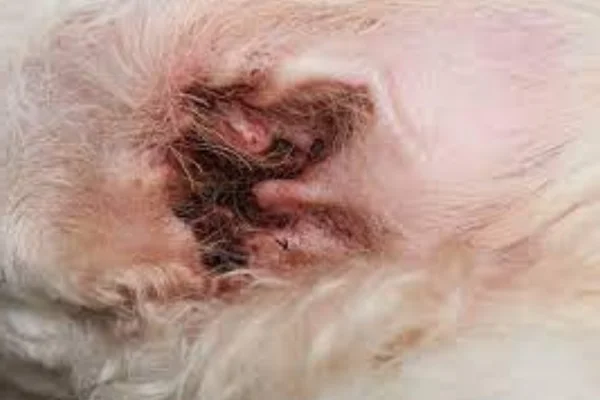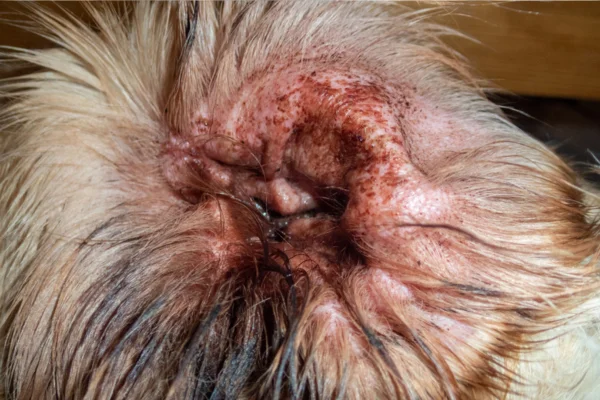Otodectic mange in dogs
Understand, Prevent and Treat This Common Problem
Otodectic mange in dogs - The relationship between humans and dogs is undoubtedly one of the oldest and deepest in history. However, like any close relationship, it comes with its responsibilities. Among the various health conditions that can affect dogs, otodectic mange is one of the most worrying.
This condition not only causes discomfort, but can also lead to more serious problems if not treated properly. Let's explore what otodectic mange is, its symptoms, causes and how to look after your four-legged friend if he is affected.
What is Otodectic Scabies?
Otodectic mange, popularly known as ear scabies, is an infection caused by the mite Otodectes cynotis. These microscopic parasites inhabit dogs' ear canals, feeding on cerumen and skin secretions, which causes irritation and inflammation.
Although it is a common condition in dogs, especially puppies and street animals, otodectic mange can also affect cats and other small mammals. The disease is highly contagious and is easily transmitted between animals through direct contact.

Otodectic mange symptoms
One of the first signs that something is wrong with your dog's ears is intense itching. The dog may start scratching its ears more frequently or rubbing them against surfaces such as furniture and carpets. Other signs include:
- Unpleasant odorThe accumulation of cerumen and secretions caused by the presence of mites can generate a strong, unpleasant smell.
- Dark secretion: The mites produce a characteristic dark brown or black secretion that resembles coffee grounds. This is one of the most obvious signs of otodectic mange.
- Redness and inflammationThe constant irritation caused by dust mites can result in inflammation and redness in the affected area.
- Hair lossWith excessive itching, it is common for dogs to lose hair around their ears.
- Unusual BehaviorThe discomfort can cause the dog to become more irritable or depressed. In more serious cases, they may lose their appetite and become listless.
-
Otodectic mange in dogs
How is the diagnosis made?
If you notice any of these symptoms, it is essential to take your dog to the vet. Diagnosis of otodectic mange is usually made through a physical examination and analysis of a sample taken from the animal's ear. The vet uses an otoscope to visualize the ear canal and can identify the mites directly. In some cases, a cerumen sample is taken and examined under a microscope to confirm the presence of the parasites.
Treatment of Otodectic Scabies
Once the diagnosis has been confirmed, treatment for otodectic mange should be started immediately. The aim is to eliminate the mites and relieve the dog's symptoms of discomfort. Here are the main treatment methods:
1. Ear cleaning
Cleaning the ear is a crucial stage of treatment. The vet can use specific solutions to dissolve the build-up of cerumen and secretions, making it easier to remove the mites. It is important not to try to clean your dog's ears at home without guidance, as using unsuitable products or applying them incorrectly can make the situation worse.
2. Topical medication
After cleaning, the vet usually prescribes topical medication that should be applied directly to the dog's ear. These medications contain acaricidal agents, which kill the mites, and can also include anti-inflammatories and antibiotics to reduce inflammation and treat secondary infections.
3. Systemic medication
In more severe cases, or when mange spreads to other parts of the body, the vet may prescribe oral or injectable medication. These medications help fight the mites from the inside out, providing a more comprehensive treatment.
4. Follow-up treatment
Regular monitoring is vital. The vet can schedule return visits to ensure that all the mites have been eliminated and that the dog's ear is healed. In some cases, the treatment may need to be repeated or adjusted.
Prevention of Otodectic Scabies
Preventing otodectic mange mainly involves hygiene practices and parasite control. Here are some tips to protect your dog:
- Regular hygieneClean your dog's ears regularly with products recommended by the vet, especially if he has large, droopy ears, which are more likely to accumulate dirt and moisture.
- Parasite Control: Use preventative products, such as flea collars and tick killers, which are also effective against mites. There are specific products that prevent mite infestation, and the vet can recommend the most suitable one.
- Avoid Contact with Infected AnimalsBecause otodectic mange is highly contagious, prevent your dog from coming into contact with other animals that may be infected, especially in environments such as kennels, parks and veterinary clinics.
- Regular Monitoring: Always be on the lookout for changes in your dog's behavior, especially excessive itching or changes in the appearance of the ears. The sooner the condition is identified, the quicker and more effective the treatment will be.

Complications of Untreated Otodectic Scabies
Ignoring the signs of otodectic mange can lead to serious complications. Without treatment, mite infestation can result in secondary bacterial infections. Chronic inflammation of the ear, known as otitis, can become a persistent and painful condition, requiring more invasive treatments.
In extreme cases, the infection can spread to the inner ear, resulting in balance problems, deafness or even meningitis, a potentially fatal condition. That's why early intervention and proper treatment are key to avoiding these complications.
Impact on Dog Welfare
Despite being a treatable condition, otodectic mange has a significant impact on a dog's well-being. The constant itching, pain and discomfort directly affect the animal's quality of life. Affected dogs can become less active, lose interest in play and social interaction, and show changes in appetite.
The stress caused by the condition can even affect the dog's immune system, making it more susceptible to other diseases. Treating otodectic mange is therefore not just a question of eliminating the mites, but also of restoring your dog's general well-being.
The Tutor's Role in Recovery
As a guardian, you play a crucial role in your dog's recovery. As well as strictly following the vet's instructions, it's important to give your dog the emotional support it needs during treatment. Dogs that feel safe and loved tend to recover more quickly.
Patience is also essential. Treatment can take weeks, and in some cases there may be a need to adjust the therapeutic plan. Keep in touch with the vet and don't hesitate to ask questions or express concerns during the process.
Final considerations
Otodectic mange is a common condition, but it can be highly uncomfortable and harmful if not treated properly. With the right intervention and ongoing care, it is possible not only to treat the condition, but also to prevent future infestations. Keeping your dog's hearing health up to date is one way of ensuring that they continue to enjoy life to the full, without the discomfort and pain that otodectic mange can cause.
Always remember: prevention is the best cure. Watch out for the signs and act quickly to ensure that your four-legged friend is always healthy and happy. After all, your dog's well-being is directly linked to your own, making this relationship of care and affection a two-way street.









